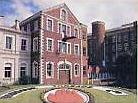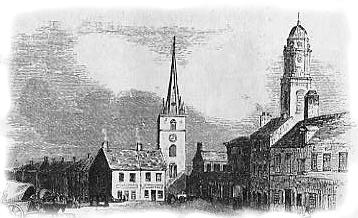Lisburn.
|
||||
|
(Ring fort of the spring.)
Lisburn and surrounding area in pre plantation times was the stronghold of the chief of Killultagh it was called Lis-na-garvoch. After the defeat of the native Irish the area was granted to Sir Faulk (Later Viscount Conway) he planted the town with settlers and in 1627 built a castle of which nothing remains today. When the Conway Castle was built the castle the settlement consisted of fifty three houses In the rebellion of 1641 Lisburn supported the crown, the town was attacked and it is said some 600 of the insurgents slain, the town was however almost totally destroyed by fire. The same fate was visited on the town in 1707, Conway's castle did not escape the flames on this occasion, one of the few buildings to survive was the Assembly Rooms which are now used as a museum, dedicated to the linen industry in the area. In Christ Church Cathedral built in 1623 as a parish
church and elevated to Cathedral status in 1662, in is is a memorial to
one Lieutenant. William Smith Dobbs, killed Lisburn was once one of the major linen towns of Ulster, in 1685 as a result of the revocation of the Edict of Nantes, by Louis XIV of France, 1685 many French Huguenots left their homeland to avoid religious persecution. A considerable number made their way to Ireland, many settling in the mid Ulster area, bringing with them their work ethic and extensive knowledge of the linen industry. The town no doubt received an economic boost when in 1765 the Lagan navigation was opened connected the town to Belfast, this enabled raw materials to be imported and finished goods to be transported to waiting ships in Belfast docks. William Coulson set up a linen mill in Lisburn in 1764, in 1784 the Barbour Mill was established at Hilden this was to become the largest manufacturer of linen thread in the world. Lisburn to the best of my knowledge was a the forefront of the industrial revolution, in 1789 a steam engine reputedly the first in Ireland was installed in Wallace's mill near Castle street The United Irishmen Revolution of 1798 inspired by the French Revolution in 1789 left its mark on Lisburn, one of its leaders Henry Monroe was a native of the town. When he was eventually captured after the failure of the rising he was hanged in sight of the shop which he ran in the town, several others from the town met with the same fate. Situated as it is astride the the river Lagan
which provided ample power to drive the many mills which grew up along
its banks. The linen was washed and bleached using the water of the river.
The first such bleaching Lisburn received an economic boost in 1839.when a railway line from Belfast reached the town. Linen continued to be produced during the second world war with the production of approximately two million parachutes. The Barbor Threads mill pictured above was once the largest producer of linen thread in the world. See also the Linen Industry. The Island Centre built on the site of one of the linen mills houses the council offices, and many amenity facilities, including It seems such a pity given the Center's location and the ample power source flowing past, that the river wasn't harnessed to heat the building, which I am sure it would have been more than capable of doing. Perhaps with environmental considerations and the ever spiraling price of fossil fuels, this may be a project for the future.
|
||||
|
|


 in
an encounter with the
in
an encounter with the  green was established
at Lambeg in 1626 a short distance from Lisburn.
green was established
at Lambeg in 1626 a short distance from Lisburn.